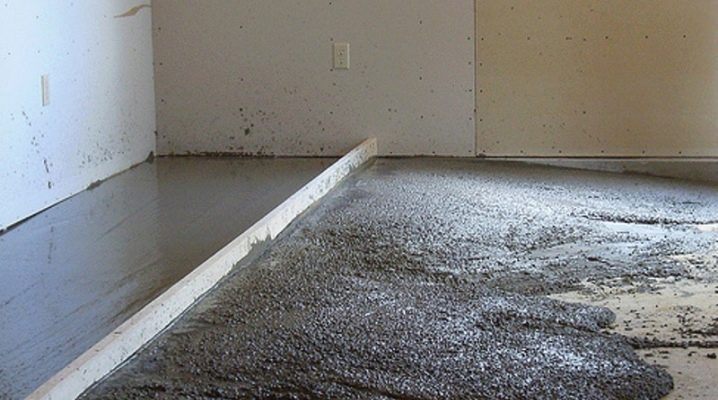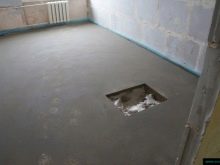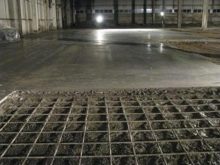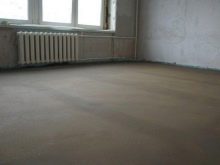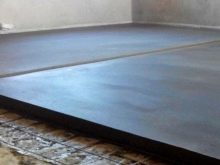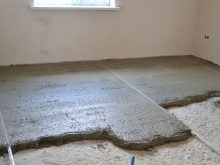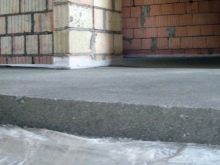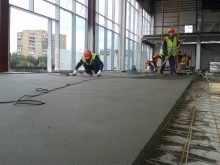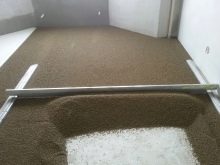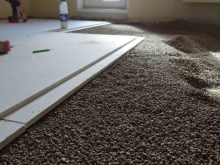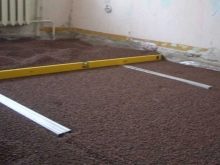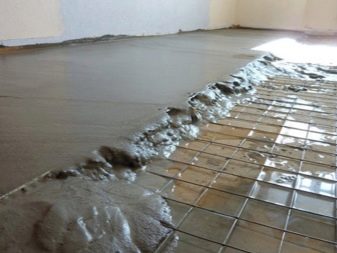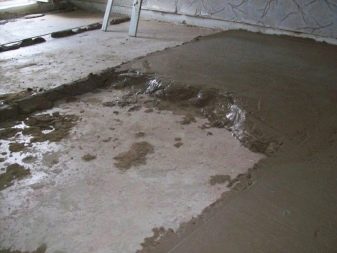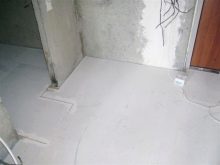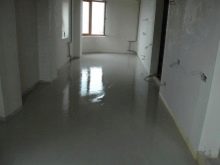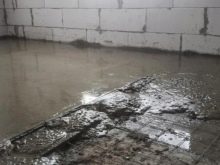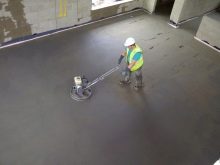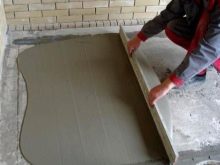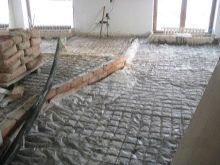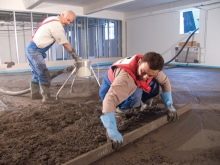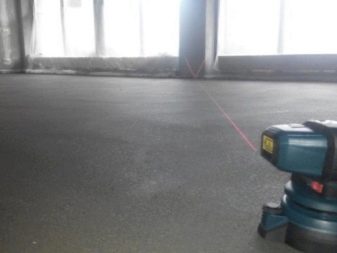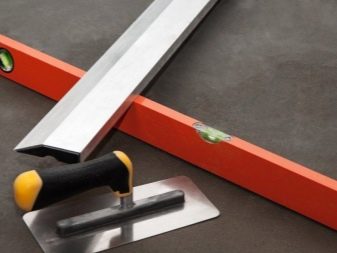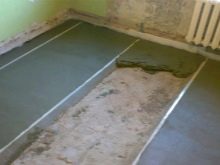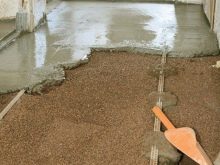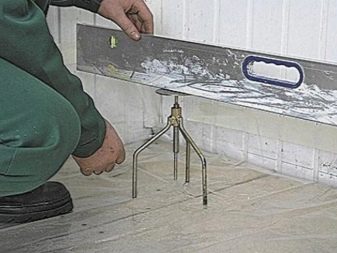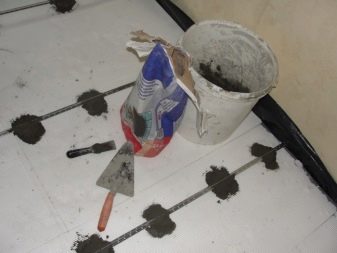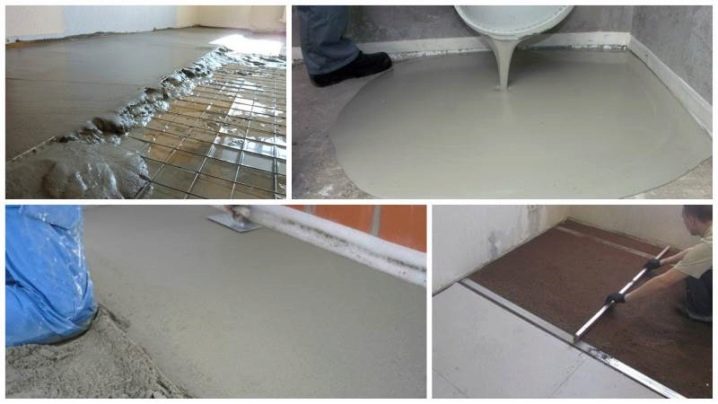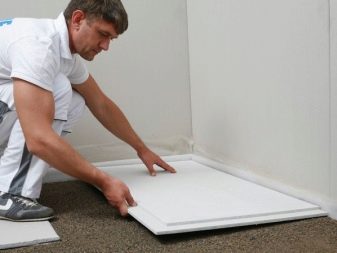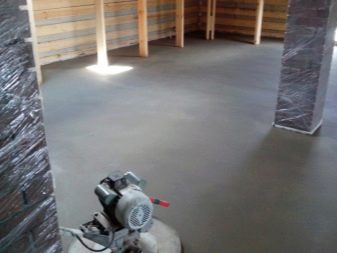Mixture consumption for screed per 1 m2: how to calculate?
The coupler is designed to level the surface and give it rigidity, as well as to hide the pipeline. In addition, the screed provides good thermal and sound insulation.
Screed properties
With the help of modern materials and technologies in the apartment or private house, you can mount the following types of screeds:
- Concrete. For its installation using various solutions. So that the coating does not fit with time, additional expansion joints are made. Finishing surface is done with diamond wheels. The advantage of such a floor is the ability to create a mosaic pattern on it;
- Cement sand. Such floors are very popular. Cement, gravel, sand and water are used to create the screed.This surface can be used as a draft or finishing layer;
- Semi-dry. The properties of this type of tie include strength, high quality and durability. Such floors shrink evenly, there are no voids and cracks. Installation is not a big deal, but it does not cost such a floor;
- Dry Such screeds are created without the use of solutions. Installation is carried out as quickly as possible, and low weight is a distinctive feature;
- Wet. The screed is made in the form of a liquid mixture, which is used for pouring floors. Thanks to this solution, a perfectly smooth surface is obtained, since the mixture spreads evenly across the floor. The screed must be further processed and the surface must be leveled with special tools;
- Gypsum. It is popular because it is environmentally friendly. For its production is used gypsum. This coating provides optimum humidity and temperature in the room.
Screeds also differ in their functional purpose. There are leveling and leveling-insulating mixtures.The first ones serve only to give the surface the necessary height, to level the surface. For residential and public premises, coatings with a low density and an average level of strength can be used, and for installation of floors in high-traffic areas, coatings with maximum density and strength are required.
Types of solutions
The modern market offers a huge selection of dry and wet screeds, which differ in the type of binder. Previously, only cement-sand mortar was used, which became durable only a month later. Today, working on the laid screed can be done in a couple of days. This effect is achieved due to the presence in the composition of mixtures of polymer additives. These materials typically include two layers of coating. The first is a rough leveling, the second is thin, with which the surface becomes perfectly smooth.
The manufacture of mixtures is carried out from binding substances:
- cement;
- cement + polymer;
- gypsum;
- gypsum + polymer.
In one design, experts advise against combining cement and plaster mixes. If this combination can not be avoided, then between them you should definitely make a layer of primer.
Failure to comply with this rule will lead to the fact that the plaster will soak away from the water that is in the cement mortar and lose its shape. The best screed is the combination of the layers on the same type of binder.
Cement mixtures tend to shrink, that is, they crack during drying. Polymer additives do not allow this. Plaster mixes do not shrink, besides, their advantage is environmental friendliness. Such floors absorb excess moisture in the air. Often, liquid glass is used for concrete mixes, which provides a solid and durable surface.
Floor measurement
First of all, the floor screed is performed to eliminate all surface defects. Before proceeding to the preparation of the solution, it is necessary to determine the degree of irregularities. Without the help of special tools in this case is not enough.
You will need:
- building level required length;
- hydro level, which is needed for more accurate measurement of the condition of the floor;
- laser level.
First set the zero level. To do this, move the special tool around the room, make the appropriate marks, which then connect the lines.This is exactly what determines the horizontal plane. From the zero level, measure the distance to the floor. After recording all the indicators, determine the maximum height. The lowest value will indicate the highest point, and vice versa.
How to count the number?
When planning a floor screed, it does not matter whether it is dry, wet or semi-dry, you must first calculate the amount of the necessary materials. The volume of cement or sand required per 1 m2 will help to find out a special formula.
Calculations are performed in the following order:
- for example, it is necessary to calculate the floor screed for a layer 5 cm thick (50 mm) and an area of 40 m2. It is necessary to multiply these two indicators; get 2 cubic meters of the mixture;
- then, according to the ratio of 1: 3, you need to know the necessary amount of cement and sand. In our case, we need 0.5 m3 of cement and 1.5 m3 of sand;
- to make it easier to calculate the amount of material, cubic meters must be converted to kilograms. The weight of a cubic meter of cement is 1300 kg, which means that 0.5 should be multiplied by 1.3. Get 6.5, that is 650 kg.
This example clearly demonstrates how to calculate the quantity needed to buy the necessary materials to fill the floor.Be sure to consider the fact that in the process of preparation, the composition for pouring decreases in volume. This is the norm. It is better to buy a little more bags of concrete, sand or other materials. To determine the amount of mixture for floor screed, we must remember that from 1 m3 of the mixture is obtained 0.6 m3 of solution.
The ratio of all materials and water can be easily calculated using a special calculator. Also with it you can calculate the required amount of self-leveling material to get a perfectly flat surface. Different mixes for filling the floor are not cheap, so you need to perform all the calculations in advance, determine the exact number of consumables. It doesn’t matter what you plan to make a screed: from sand concrete, DSP or sand mixture. The correct calculation of materials is a guarantee of a high-quality and durable surface.
Preparation of materials
Once you have decided on the type of screed, purchased all the necessary materials, you must begin to prepare the floor surface. First of all, you need to remove the old tie, if there is one. Then thoroughly clean the surface from dirt and dust.If desired, the cleaned floor can be primed, but this process is not necessary. The thickness of the screed is important both in the apartment and in a private house. The degree of thermal insulation depends on this indicator. Thickness may vary depending on the selected materials and floor space, but do not forget to take into account the fact that the screed incorrectly selected thickness may be of poor quality.
Before proceeding with the installation of the screed, it is necessary to set up beacons around the perimeter. With their help, you can fill the floor as smoothly as possible. If additional support is needed, do not use wooden blocks. Under the influence of moisture, they are deformed. When installing a semi-dry screed on the walls, doorways and partitions insulating material is laid. Its role can play a damper tape, which is made of high quality polyethylene foam. At the end of the tape is easy to remove, it leaves no residue.
Then proceed to the preparation of the mixture. This process depends on the materials you will use. The main thing - keep proportions.
As floor coverings are usually used:
- Linoleum. Differs affordable cost and ease of installation.Modern types of this material are eco-friendly and textured. Roughly speaking, in order to lay linoleum, you just need to roll a roll;
- Laminate. A special feature is the stylization of natural wood. This material allows height differences of no more than 2 mm per 1 m2. This coating looks aesthetically pleasing;
- Parquet. It is a sign of respectability. Since it is natural, it is not cheap. Keep in mind that the parquet needs special care;
- Carpet. Mimics the carpet. It can even be laid on the surface with minor defects. Installation of carpet is nothing complicated, it does not need to be additionally fixed;
- Ceramic tile. Suitable in rooms with high humidity. This material is placed on a perfectly flat surface, so installation requires maximum patience.
Each of the above materials has both advantages and disadvantages. All coatings require high-quality styling mixture laying.
Expense calculation
To assess the quality of the screed and calculate the consumption of materials, while saving money, you must perform the following steps:
- Assess the uniformity of the screed.The color over the entire area of the room should be equally gray;
- Rate the quality of the surface. For this, the two-meter rule applies. It should just be put in the floor, checking for the presence of gaps. Empty space is not more than 4 cm is acceptable;
- Evaluate the strength. Apply a few blows with a hammer on the tangent. If the traces of the blows are almost imperceptible, then the installation work on the screed is done qualitatively.
When you purchase the necessary materials for the screed, please note that you will spend 10 bags with the mixture for 8 square meters. It will cost you quite inexpensively. To save on the solution, make a rough screed floor. For her use cheap materials. Then you can complete the finish line. If you are important to save finances, then note that reinforcement increases the consumption of the mixture. At the same time, reinforced mesh makes the coupler more durable, provides a long service life.
Nuances and recommendations
You can make a floor screed yourself, without the help of experienced professionals, even if you have no experience in construction.
When performing all the work, the main thing is to follow the instructions, to observe the sequence of all procedures,Take into account the advice of professionals:
- In no case do not need to do the work of installing a tie in a hurry. If you plan to finish the floor with laminate or parquet, and in a hurry to install these materials on a wet surface, then you will have to tear them off, as they are unstable to moisture. All work can be continued only after the screed has completely dried, and this may take even a month;
- Many want the screed to dry as quickly as possible, and for this they create indoor drafts, including drying or heaters. From this surface can begin to crack. Professionals advise to slightly moisten the tie for 3 days to prevent the formation of cracks;
- In order not to damage the finishing material during operation, you must first lay the floor with a special gasket, and only then install laminate, parquet or other finishing materials.
To prevent the formation of cracks on the finished screed, during its laying it is necessary to make shrinkable seams in the material. Thanks to them, there will be no cracks and cracks in the surface. Please note that the thickness of the concrete screed is directly dependent on the room in which it is made.In order to avoid defects after installation work, it is recommended to first calculate the height of all subsequent layers throughout the building.
Differences in size will be if the finish is used different. For example, linoleum spreads on plywood, and parquet - on special lags. In the bathroom, as a rule, install vinyl tiles and the system "warm floor". That is why the optimal thickness of the screed in the bedroom - 60 mm, in the hallway - 27 mm, in the office space - 84 mm. Mandatory layer of the screed is waterproofing. It provides good mortar setting. To prevent the formation of shells, it is necessary to thoroughly seal the mixture. After the water-repellent layer, thermal and noise insulation layers are laid.
Screed with your own hands - this is a very simple process, if you buy quality materials, prepare in advance all the necessary tools and have patience. If you are not confident in your abilities, it is better to immediately contact a specialist for help. After all, the mistakes made during the laying of the screed will be quite difficult to eliminate.
How to calculate the flow rate of the mixture for the screed, see the following video.
